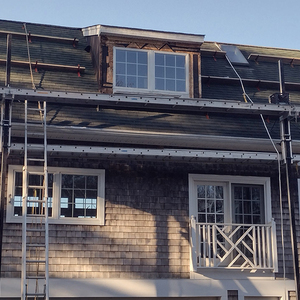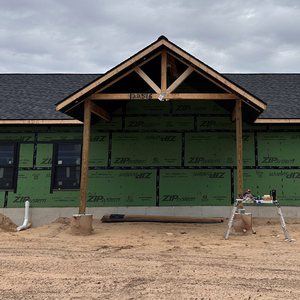Thanks for defending the do-it-yourselfers
Hurrah for Kevin Ireton’s reply to Mr. Wagner about the “cheapskate” kitchen remodel (FHB #153, “Letters,” p. 6). My husband and I have subscribed to Fine Homebuilding and Fine Woodworking for some time now, and neither of us is employed in craft trades. Instead, we are both history professors who greatly enjoy both woodworking and home improvement. We are now working on our third home: What was a rather boring 1970s plain ranch is now an attractive ranch with an Arts and Crafts touch.
What a joy it is to do something well and to do it oneself. Although I believe that we are all worth our hire, I take exception to those who promote the idea that only “professionals” can do the job well. When I look at the work of some “professionals,” I know that I would never want them working on my home. There is often more to a decision than the bottom line.
I appreciated that you stuck up for
those of us who care about doing good
work.
—Wendy Butler, via e-mail
The quick-change house
With regards to universal design (FHB #153, “Letters,” pp. 10, 12), admittedly custom-home buyers have every right to a distinctive home. They should know that special touches can make resale more difficult, but that’s a trade-off, and it’s their choice to make. At the same time, the designing mind might accept a lesson from the computer user’s delight in “big” software. A word-processing program or an Internet browser can do 10 times what we need, but it’s nice to know the tools are there for when life changes.
For example, consider “universal” wiring. It’s short-sighted to put in some phone wires and quit the job. But it’s just as short-sighted to go wild with fiber optics, coaxials, network multiconductors and intercom wires. The only sensible way to install low-voltage wiring is to run fat, empty conduits to every room, with blank face plates and permanent double-length pull cords. That way, progress is built in.
So the general answer is not put it in or leave it out. The synthesis of both views is to leave it out but to put in all the infrastructure to install just about anything later, without ripping up the structure itself.
— David Royce, via e-mail
Improper crawlspace details wrecked a structure in seven years
I saw your article on moisture problems and crawlspaces (FHB #153, “Sealing a Crawlspace,” pp. 94-99). A few years back, I repaired the wood-frame floor over an improperly constructed crawlspace. The previous contractor committed all the errors that led to complete structural failure. Within seven years, the floor joists and built-up beams rotted through and collapsed. Inside, he installed no vapor barrier over the dirt floor and provided no ventilation or even access to the crawlspace. He also installed the vapor barrier for the insulation so that it didn’t protect the framing. Outside, he pitched grade toward the building. The power of moisture in the right circumstances can be disastrous.
—John A. Rosa, Wolcott, CT
Don’t endorse fakery
A while ago, you ran a feature article on how to install vinyl siding—surely the ultimate in cheap house finishing—and in the last issue you’ve got one titled “Rejuvenating an Old Porch”(FHB #153, pp. 64-67), with a subtitle that reads “PVC rails and fiberglass columns keep the look classic and the maintenance minimal.” Neither of these articles has any business inside the covers of a magazine that calls itself Fine Homebuilding, and I know I’m not alone in thinking that.
There is no reason on earth that a house cannot be built to last more than a hundred years, barring natural disasters and operator error. But houses that are now that old were not built with such items as engineered lumber, PVC siding and plastic water pipes. They were not framed with green lumber that measured only 65% of the cross section of the nominal specification. And perhaps most important, they weren’t banged together by people whose knowledge of house construction was limited to one narrow specialty and who, if asked what they were making, would be more likely to reply “money” than “homes.” Today, sadly, even many high-end, so-called custom-home builders are generally guilty of all these practices.
Fine Homebuilding, by virtue of its standing in field, has the power to validate and give credence to pretty much anything featured in its pages. I think you have to be very careful not to endorse fakery by publishing articles about how it’s done. You can print all the disclaimers you want. The very fact that it’s in your pages does one of two things: It endorses the technique or material, or it downgrades your credibility. Neither is a good choice for you.
—T. H. Richards, Mont-Tremblant, QC, Canada
Maybe vinyl is all we deserve on homes today
I read all the emotional letters in FHB #152, describing damages from vinyl siding to this country’s architectural heritage. My question is does today’s “architectural heritage” deserve any better than plastic? What is behind the vinyl covering in 99% of our homes? Only plastic, particleboard, paper and unprotected electrical wires, nailed together by people without professional training or education.
When we start to build more solid houses in this country, like the houses in Germany or France, or even those in Lebanon and Saudi Arabia, then we’ll have the right to criticize and make statements that vinyl siding is not suitable.
—Zachary Kaminsky, Charlotte, NC
Don’t use AFCIs on three-wire circuits
Your article about arc-fault circuit interrupters (FHB #152, pp. 100-103) omitted an important warning: AFCIs cannot be used on three-wire circuits (where a single three-wire cable is run to feed two circuits in lieu of two two-wire cables). And those who don’t understand three-wire circuits should not even open the panel cover. Pulling the wrong neutral or adding an AFCI to a three-wire circuit can cause an interesting problem: 220v. Very bright lights and a smoking computer. And in my opinion, a neutral shock is more painful than a hot shock. Warn your readers: If you don’t know, call a pro.
—Mark Heller, San Francisco, CA
A different opinion about vibration and front-loading washers
I was surprised to read Jeff Beneke’s letter complaining about vibration from front-loading washers (FHB #153, pp. 6, 8). I too have a Sears Kenmore front-loading washer on the second floor of my new home. It is in a closet sitting on a 12-in. raised platform over 16-in. I-joists. We have been using this washer for almost four months and have had no problems with excessive vibration. Sometimes it is a bit louder than others, but we have never felt it necessary to stop the spin and rearrange the items in the washer for a smoother spin cycle. Our previous top-loading Kenmore washer occasionally had problems with out-of-balance loads, but the front-loader has been immune to those problems in our experience.
—Frank J. Knight, New Gloucester, ME
Applauds author’s humility
In his letter to the editor (FHB #153, pp. 8, 10), Keith Metler pointed out the problem of lateral spreading that can occur when ceiling joists or collar ties are removed from rafter framing. As a practicing architect and engineer, I’ve been involved in the reconstruction of entire roofs when this phenomenon was ignored or forgotten about.
I appreciate author John Michael Davis’s response: “I wish I could say I had considered this issue and concluded that it didn’t matter. But I never even thought about it and that upsets me.” It is refreshing to hear such a candid and honest reply. These words should be given due consideration by all in this profession. When I graduated from college, I was confident in my knowledge about building design. Now that I have been practicing for 25 years, I am in awe of the skill and expertise required for each well-done project. I realize that the problems that can develop in design (and cost-estimating) are not caused by the items you figured, but by what you overlooked.
There is a Bible proverb that says, “Plans fail for lack of counsel, but with many advisers they succeed.” Do not be afraid to get a second opinion and stay humble.
—Kenneth H. Karle, Midland Park, NJ
A good Internet source for Torx-head screws
Thank you for the article “The New Wood Screw” in the February/March issue (FHB #153, pp. 74-77). I was surprised that the author gave the Web addresses for the Spax, McFeely and Swan products, but did not give one for the Torx-head products. I buy Torx-head wood screws from Screw Products Inc. at www.screw-products.com(don’t forget the hyphen in the address). They have been very responsive and helpful.
Because of the flawless grip of the Torx-head, it is somewhat easier to snap off the heads in tough woods. But precisely because of that flawless grip, I’ll never again buy any other type of wood screw. The Torx-head screws are a joy to use. Friends and relatives to whom I’ve introduced the Torx-head wood screw inevitably rave about it too and want to order more.
—Ray Bishop, via e-mail
You misspelled silicon
In reference to James Kidd’s article in FHB #153 (“What’s The Difference?” p. 128), the author should leave silicone to be used in caulking sealants and breast implants. Silicon would continue to be reacted with carbon to form the silicon carbides that are used as abrasives. Even excellent magazines are known to have minor burps.
—Bob Gardner, Collingwood, ON, Canada
Cabinets don’t always need to be reinforced for concrete counters
My wife and I have been producing concrete countertops for nine years at Grotto Designs in Calgary, Alberta. We have installed hundreds all over western Canada. We admire Fu-Tung Cheng’s work tremendously but would like to point out that we rarely require cabinets to be reinforced (FHB #152, “Questions & Answers,” p. 22). Our standard product is precast 11⁄2 in. thick in a shop and is reinforced with light steel or glass fibers. Using a lightweight aggregate, the concrete weighs in at 13 lb. to 14 lb. per sq. ft. (traditional concrete weighs around 18 lb. per sq. ft. at 11⁄2-in. thickness). We install these countertops on standard modular cabinets that generally use 1⁄2-in. backs and 5⁄8-in. composite sides. We have never had a problem or a callback due to cabinet failure. We regularly free-span dishwasher openings and 36-in. cabinets without solid tops. Twelve-in. cantilevers are common. Typically, we require reinforcement only for undermount sinks and where racking may be a problem.
—Tim Murphy, Calgary, AB, Canada
Do you know where the stress is in a concrete wall?
In the December/January issue, your article “A Stone House in Two Weeks” (FHB #152, pp. 76-79) might have missed the target when it stated that 1⁄2-in. rebar was placed “in the middle of the concrete (wall) for maximum strength.” The middle of the wall should be the location of minimum bending stresses.
Plain concrete should be strong enough to resist any compressive forces that might be applied. The reinforcing steel might be needed to resist bending forces. However, any bending stresses would approach zero at the center, or neutral axis, of the concrete with maximum stress occurring at each face of the wall.
—Alva Hill Rutledge, P. E., Madison, MS
Too many expensive houses
When I first subscribed to Fine Homebuilding several years ago, the featured houses were fairly modest. They provided my wife and me with many ideas and inspirations for our house. Lately, though, it seems that the majority of the featured houses are astronomically expensive and are emphatically not what I want to see in FHB. The house on the cover of the February/March 2003 issue is one of these. The architect’s fee for this house would probably have paid the building cost of our house.
May I suggest that you reread Sarah Susanka’s book The Not So Big House and then start featuring houses that are affordable by the merely affluent rather than by the extraordinarily wealthy few? Your fine magazine will be even better if you do.
—Alan Berens, Lincolnville, ME
Don’t buy cheap pipe
In your February/March issue (FHB #153, pp. 84-87), I was disappointed that you did not address the big differences between the different types of PEX tubing and the failure rate of some of the types of tubing. The author said that he preferred one type over another, but he should have mentioned why. Some brands, such as Wirsbo, cost more, but they have been around for years with no failures. Others have been on the market for a short time and have a high rate of failure.
I realize the liability of saying too much, but your readers need to know that you get what you pay for when it comes to PEX, and cheap usually means cheap.
—Steve Eayrs, Homer, AK
Questions author’s comments on AFCIs
How ironic that Rex Cauldwell’s sidebar to “Arc-Fault Circuit Interrupters?” (FHB #152, p. ???) starts off with “It would be irresponsible…” In this lopsided treatement, I find many of Rex’s statements to be very irresponsible. First, Rex seems to ignore (or be unaware of) the currenttime characteristics of standard breakers. UL testing procedures allow standard 15-amp breakers to pass instantaneous currents of over 300 amperes. The time to trip at 75 amperes is much shorter for the AFCI than for standard breakers, hence Rex’s assertion that “we have that feature in effect in a common breaker” is wrong.
Second, Rex states: “But even this method doesn’t detect true series arcs: It detects them indirectly as they occur.” The breaker detects only “false” arcs? Whether it detects the arc directly or indirectly, the breaker does detect the arc. The UL testing methods demonstrate that capability.
Third, Rex’s analysis of the increased cost of AFCIs over conventional breakers is skewed. The cost to the consumer does not rise by the dramatic “8 to 10 times” he claims. The consumer pays for the labor to install the breaker, as well as the breaker itself. From the National Construction Estimator, the total materials and labor to install a 200-amp service panel is over $1,200, and to wire a 2,000 sq. ft. house over $10,000. Assuming a four-bedroom house, with four AFCI breakers, the additional cost should be about $150. That means that the increase to the consumer is less than 15% on just the service panel, and about 1.5% on the whole house. That is a small price to pay to reduce the risk of fire and the potential loss of life.
Finally from the main article: “I’ve actually arc-welded with hot conductors without tripping the breaker.” Please don’t try this at home!
—Jon Tandy, Greentown, PA
Fine Homebuilding Recommended Products
Fine Homebuilding receives a commission for items purchased through links on this site, including Amazon Associates and other affiliate advertising programs.

8067 All-Weather Flashing Tape

Reliable Crimp Connectors

Affordable IR Camera






















